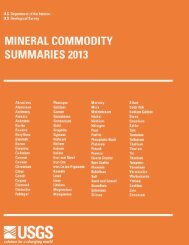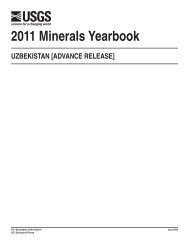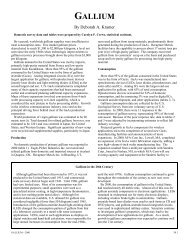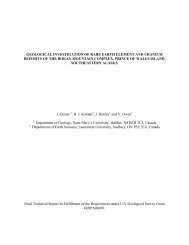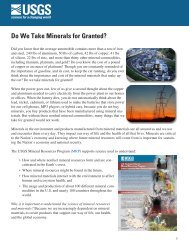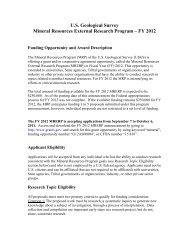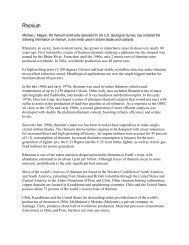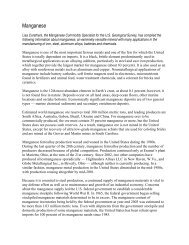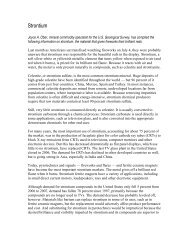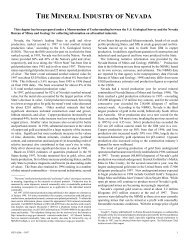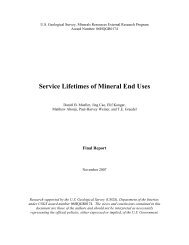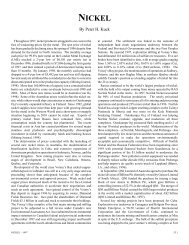Mineral Commodity Summaries 2003 - Mineral Resources Program ...
Mineral Commodity Summaries 2003 - Mineral Resources Program ...
Mineral Commodity Summaries 2003 - Mineral Resources Program ...
You also want an ePaper? Increase the reach of your titles
YUMPU automatically turns print PDFs into web optimized ePapers that Google loves.
118<br />
NITROGEN (FIXED)—AMMONIA<br />
(Data in thousand metric tons of nitrogen, unless otherwise noted)<br />
Domestic Production and Use: Ammonia was produced by 19 companies at 37 plants in the United States during<br />
2002. Fifty-three percent of total U.S. ammonia production capacity was centered in Louisiana, Oklahoma, and Texas<br />
because of their large reserves of natural gas, the dominant domestic feedstock. In 2002, U.S. producers operated at<br />
about 57% of their rated capacity. The United States remained the world’s second largest ammonia producer and<br />
consumer following China. Urea, ammonium nitrate, ammonium phosphates, nitric acid, and ammonium sulfate were<br />
the major derivatives of ammonia in the United States, in descending order of importance.<br />
Approximately 88% of apparent domestic ammonia consumption was for fertilizer use, including anhydrous ammonia<br />
for direct application, urea, ammonium nitrates, ammonium phosphates, and other nitrogen compounds. Ammonia<br />
was also used to produce plastics, synthetic fibers and resins, explosives, and numerous other chemical compounds.<br />
Salient Statistics—United States: 1<br />
1998 1999 2000 2001 2002 e<br />
Production 2<br />
13,800 12,900 12,500 9,730 9,500<br />
Imports for consumption 3,460 3,890 3,880 4,550 4,600<br />
Exports 614 562 662 647 650<br />
Consumption, apparent 17,100 16,300 15,600 13,800 13,500<br />
Stocks, producer, yearend 3<br />
1,050 996 1,120 916 900<br />
Price, dollars per ton, average, f.o.b. Gulf Coast 3<br />
121 109 169 183 140<br />
Employment, plant, number e<br />
Net import reliance<br />
2,500 2,200 2,000 1,800 1,700<br />
4 as a percentage<br />
of apparent consumption 19 21 20 30 29<br />
Recycling: None.<br />
Import Sources (1998-2001): Trinidad and Tobago, 59%; Canada, 24%; Ukraine, 5%; and other, 12%. U.S. Census<br />
Bureau data for Russia and Ukraine were included only in 2001.<br />
Tariff: Item Number Normal Trade Relations<br />
12/31/02<br />
Ammonia, anhydrous 2814.10.0000 Free.<br />
Ammonia, aqueous 2814.20.0000 Free.<br />
Urea 3102.10.0000 Free.<br />
Ammonium sulfate 3102.21.0000 Free.<br />
Ammonium nitrate 3102.30.0000 Free.<br />
Depletion Allowance: Not applicable.<br />
Government Stockpile: None.<br />
Events, Trends, and Issues: Low ammonia prices and high inventory levels in the first part of the year led some<br />
ammonia producers to temporarily idle a significant portion of their ammonia production capacity. One company<br />
closed its 93,000-ton-per-year ammonia plant in Pocatello, ID, in August, citing global competition as the reason for<br />
the closure. In order to remain competitive, the company either would have had to upgrade its existing plant or<br />
construct a new plant. By the fourth quarter, much of the idled capacity came back on-stream as ammonia prices<br />
began to climb, reflecting an increase in natural gas prices. The largest ammonia producer in the United States filed<br />
for Chapter 11 bankruptcy protection in June, citing adverse market conditions in the nitrogen fertilizer market and<br />
cash demands. The producer, a co-op, operates seven ammonia plants in Iowa, Kansas, Louisiana, Nebraska, and<br />
Oklahoma, with a total capacity of 3,040,000 tons per year of ammonia; two plants, with a total capacity of 890,000<br />
tons per year, were closed throughout 2002.<br />
Ammonia imports continued to increase to replace declining U.S. production, but less dramatically than in 2001<br />
because the drop in domestic production was not as large. Based on partial-year data, Trinidad and Tobago (50%),<br />
Canada (18%), and Ukraine (11%) were the largest source countries.<br />
In October, the International Trade Administration, U.S. Department of Commerce, announced preliminary<br />
antidumping duties on urea ammonium nitrate (UAN) solutions imported into the United States from Belarus, Russia,<br />
and Ukraine. For Belarus, the duty was 190.34% ad val.; for Russia, 138.95% to 233.85% ad val.; and for Ukraine,<br />
193.58% ad val. The investigation of UAN imports began in April when U.S. producers claimed that unusually high<br />
levels of low-cost imports from the three countries began in 2000 and were damaging domestic UAN operating rates.<br />
Prepared by Deborah A. Kramer [(703) 648-7719, dkramer@usgs.gov, fax: (703) 648-7722]



